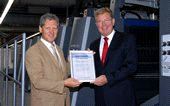Offset Printing
UD Print AG Produces with Worlds First Certified Carbon-Neutral Speedmaster XL 105 Press from Heidelberg

Friday 25. July 2008 - UD Print AG offsets CO2 emissions in press manufacture Heidelberg commissions environmental impact experts to calculate CO2 volumes
UD Print AG in Lucerne, Switzerland, has recently begun production operations using the worlds first certified carbon-neutral Speedmaster XL 105-5+LX sheetfed offset press from Heidelberger Druckmaschinen AG (Heidelberg). The greenhouse gases produced in manufacturing the press have been calculated and offset. Environmental impact experts PE International took account of all relevant parameters, from extracting raw materials and material production to press manufacture, testing, and transportation to the print shop.
According to a study by PE International, manufacture of a Speedmaster XL 105-5+LX equates to emissions totaling 320 tons of carbon dioxide. That is roughly one tenth of the volume of carbon dioxide generated each year from manufacture of print products on such a press, with the proportion of paper making up around 90 percent of the total carbon dioxide volume.
“This certificate underlines our environmental responsibility and we are proud to be pioneers in sustainability,” explains Ulrich Bigler, Manager of UD Print AG. In this way, the company is a model business in terms of its energy efficiency.
Carbon dioxide emissions are offset through purchasing and cancelling 320 emission credits (1 = 1t CO2e) which come from the Te Apiti wind farm WWF Gold Standard CDM climate protection project in New Zealand. The project is in line with the Clean Development Mechanism (CDM), which is entrenched in Article 12 of the Kyoto Protocol. Te Apiti is the first wind farm in New Zealand that provides consumers with electricity directly and covers a total of 45,000 households. Wind power is a renewable energy source and thus ensures sustainable environmental development.
Emissions savings are regularly verified and certified by TÜV Süd. Cancellation certificates are recorded and issued by the Swiss National Emissions Trading Registry.
Heidelberg presses – with or without a climate certificate
In order to assess the climate effect of its production, Heidelberg provided the environmental impact experts with all relevant information from its Amstetten, Brandenburg, and Wiesloch-Walldorf plants and external areas of the production chain. Missing data in the supply chain, for example for standard electronics components, was compensated for by generously rounding up the results. All emissions from manufacturing are therefore covered.
In the future, Heidelberg will be offering this service to all its customers, who will be able to choose between “regular” Speedmaster XL 105 presses or those with a climate certificate. For all other presses, this service is available on demand. Heidelberg is thus the first mechanical engineering company to offer its customers a package of this type.
Energy recovery in a closed cycle
UD Print AG is the parent company of the UD Media Group. Its over 120 employees produce advertising materials, catalogs, magazines, and books. In November 2007, the company moved into a new, state-of-the-art building in Lucerne.
As well as UD Print AG, the three other divisions UD Neue Medien, UD Verlag and UD Promotion have also moved into the new building. The UD Media Group has a total workforce of 170 employees.
UD Print AG itself has a production area of 2,000 square meters with optimal conditions for horizontal material logistics, from the paper store and printing process to postpress and shipping. The pressroom already houses both a Speedmaster SM 102 five-color and ten-color press.
The UD Media Group has invested significant sums in energy recovery using a closed hot/cold water cycle. The system keeps the company largely independent from external energy sources and cuts fossil energy needs to a minimum to ensure CO2 emissions are as low as possible.
